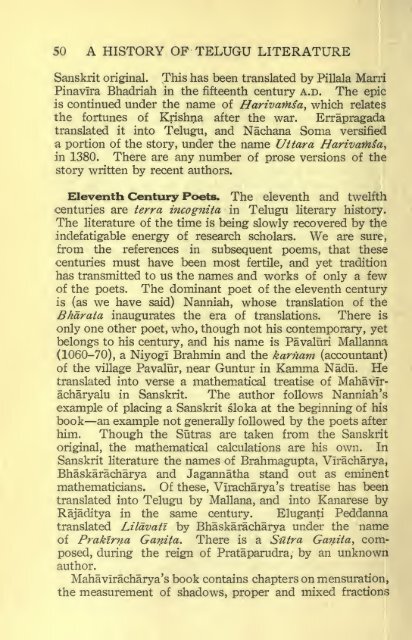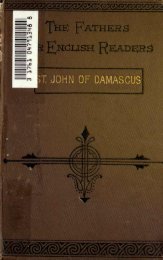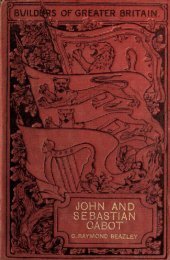A history of Telugu literature; - Cristo Raul
A history of Telugu literature; - Cristo Raul
A history of Telugu literature; - Cristo Raul
You also want an ePaper? Increase the reach of your titles
YUMPU automatically turns print PDFs into web optimized ePapers that Google loves.
50 A HISTORY OF TELUGU LITERATURE<br />
Sanskrit original. This has been translated by Pillala Marri<br />
Pinavira Bhadriah in the fifteenth century A.D. The epic<br />
is continued under the name <strong>of</strong> Harivamsa, which relates<br />
the fortunes <strong>of</strong> Krishna after the war. Errapragada<br />
translated it into <strong>Telugu</strong>, and Nachana Soma versified<br />
a portion <strong>of</strong> the story, under the name Uttara Harivamsa,<br />
in 1380. There are any number <strong>of</strong> prose versions <strong>of</strong> the<br />
story written by recent authors.<br />
Eleventh Century Poets. The eleventh and twelfth<br />
centuries are terra incognita in <strong>Telugu</strong> literary <strong>history</strong>.<br />
The <strong>literature</strong> <strong>of</strong> the time is being slowly recovered by the<br />
indefatigable energy <strong>of</strong> research scholars. We are sure,<br />
from the references in subsequent poems, that these<br />
centuries must have been most fertile, and yet tradition<br />
has transmitted to us the names and works <strong>of</strong> only a few<br />
<strong>of</strong> the poets.<br />
The dominant poet <strong>of</strong> the eleventh century<br />
is (as we have said) Nanniah, whose translation <strong>of</strong> the<br />
Bharata inaugurates the era <strong>of</strong> translations. There is<br />
only one other poet, who, though not his contemporary, yet<br />
belongs to his century, and his name is Pavaluri Mallanna<br />
(1060-70), a Niyogi Brahmin and the karnam (accountant)<br />
<strong>of</strong> the village Pavalur, near Guntur in Kamma Nadu. He<br />
translated into verse a mathematical treatise <strong>of</strong> Mahaviracharyalu<br />
in Sanskrit. The author follows Nanniah's<br />
example <strong>of</strong> placing a Sanskrit sloka at the beginning <strong>of</strong> his<br />
book an example not generally followed by the poets after<br />
him. Though the Sutras are taken from the Sanskrit<br />
original, the mathematical calculations are his own. In<br />
Sanskrit <strong>literature</strong> the names <strong>of</strong> Brahmagupta, Viracharya,<br />
Bhaskaracharya and Jagannatha stand out as eminent<br />
mathematicians. Of these, Viracharya's treatise has been<br />
translated into <strong>Telugu</strong> by Mallana, and into Kanarese by<br />
Rajaditya in the same century. Eluganti Peddanna<br />
translated Lilavatl by Bhaskaracharya under the name<br />
<strong>of</strong> Praklrna Ganita. There is a Sutra Ganita, composed,<br />
during the reign <strong>of</strong> Prataparudra, by an unknown<br />
author.<br />
MahaViracharya's book contains chapters on mensuration,<br />
the measurement <strong>of</strong> shadows, proper and mixed fractions

















